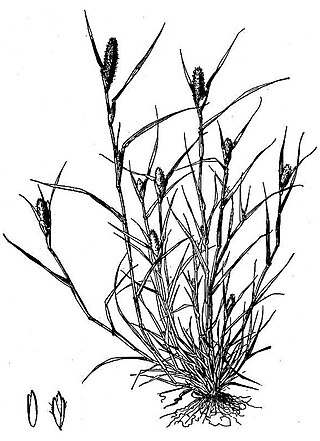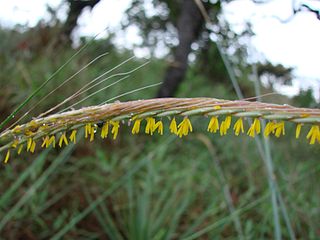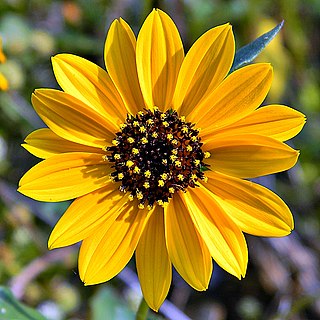
Allium canadense, the Canada onion, Canadian garlic, wild garlic, meadow garlic and wild onion is a perennial plant native to eastern North America from Texas to Florida to New Brunswick to Montana. The species is also cultivated in other regions as an ornamental and as a garden culinary herb. The plant is also reportedly naturalized in Cuba.

Sporobolus is a nearly cosmopolitan genus of plants in the grass family. The name Sporobolus means "seed-thrower", and is derived from Ancient Greek word σπόρος (spóros), meaning "seed", and the root of βάλλειν (bállein) "to throw", referring to the dispersion of seeds. Members of the genus are usually called dropseeds or sacaton grasses. They are typical prairie and savanna plants, occurring in other types of open habitat in warmer climates. At least one species is threatened with extinction, and another is extinct.

Crypsis is a genus of African and Eurasian plants in the grass family, sometimes referred to as pricklegrass. These are annual grasses with short leaves. A few species are invasive weeds outside their native ranges.

Heteropogon is a genus of annual and perennial plants in the grass family known generally as tangleheads, widespread primarily in tropical and subtropical regions.

Stenanthium is a North American genus of flowering plants in the tribe Melanthieae of the family Melanthiaceae.

Trachypogon is a small genus of African and Latin American plants in the grass family. Crinkleawn grass is a common name for plants in this genus.

Tripogon is a genus of tropical and subtropical plants in the grass family. They are widespread across Asia, Africa, Australia, and the Americas. Fiveminute grass is a common name for plants in this genus.
Gymnopogon (skeletongrass) is a genus of American and Southeast Asian plants in the grass family.
Physaria fremontii is a species of flowering plant in the family Brassicaceae known by the common name Fremont's bladderpod. It is endemic to Wyoming in the United States, where it occurs only in and around the Wind River Range in Fremont County.

Symphyotrichum georgianum is a rare species of flowering plant in the Asteraceae, the aster family. Its common name is Georgia aster. It is native to the southeastern United States where it is known from Alabama, Florida, Georgia, North Carolina, and South Carolina. As of 2013, it may be extirpated from the state of Florida.

Helianthus debilis is a species of sunflower known by the common names cucumberleaf sunflower, beach sunflower, weak sunflower, and East Coast dune sunflower. It is native to the United States, where it can be found along the Atlantic and Gulf Coasts. It is known elsewhere as an introduced species, such as South Africa, Australia, Taiwan, Slovakia, and Cuba.

Smilax auriculata is a North American plant species native to the Bahamas, the Turks & Caicos Islands, and the southeastern United States. Common names include earleaf greenbrier and wild-bamboo, despite the fact that it is not closely related to bamboo. It is reported from Florida, Georgia, North and South Carolina, Alabama, Mississippi, and Louisiana. It grows on coastal sand dunes and in sun-lit locations in sandy woodlands at elevations of less than 100 m.

Solidago latissimifolia, common name Elliott's goldenrod, is North American species of flowering plants in the family Asteraceae. It is native to the Atlantic Coast of the United States and Canada, from Nova Scotia south to Alabama and Florida.
Koanophyllon villosum, the Florida Keys thoroughwort, or abre camino, is a species of flowering plant in the family Asteraceae. It grows in southern Florida, Cuba, the Bahamas, Hispaniola, Jamaica, and the Islas de la Bahía.

Hypericum tenuifolium, known as Atlantic St. John's-wort and sandhill St. John's-wort, is a species of flowering plant in the St. John's wort family, Hypericaceae. It is native to the Southeastern United States.

Hypericum suffruticosum, known as pineland St. John's-wort, is a species of flowering plant in the St. John's wort family, Hypericaceae. It is native to the Southeastern United States.
Hypericum galioides, the bedstraw St. Johnswort, is a species of flowering plant in the St. John's wort family, Hypericaceae. It is endemic to the Southeastern United States.

Hypericum tetrapetalum, the fourpetal St. Johnswort, is a species of flowering plant in the St. John's wort family, Hypericaceae. It is found in the Southeastern United States and Cuba. It was first described by Jean-Baptiste Lamarck in 1797.

Hypericum frondosum, the cedarglade St. Johnswort or golden St. John's wort, is a species of flowering plant in the St. John's wort family, Hypericaceae. It is native to the central and southeastern United States in dry, rocky habitats.

Hypericum fasciculatum, known as peelbark St. Johnswort or sandweed, is a species of flowering plant in the St. Johnswort family, Hypericaceae, native to the southeastern United States. It is found from eastern North Carolina, south to southern Florida, west to eastern Louisiana. Kew's Plants of the World Online database also notes that it occurs in Cuba, though Cuba is not listed in several other sources. It was first described in 1797 by Jean-Baptiste Lamarck.
















